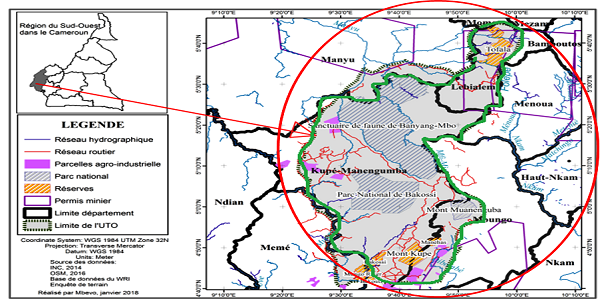
The SW Region, in which the Project is situated, is a biodiversity hotspot of global significance that supports a high diversity of animal and plant species, large numbers with restricted ranges, and many of which are threatened (Cameroon 4th CBD National Report, Chap 1. Section 1.1, 2009) The project area ranges from 180m to 2,900m above sea level, harbouring a transition from lowland forests, montane forests and montane savannahs, thus conferring an extraordinary degree of ecosystem, habitat, plant and animal diversity for all taxa. It also provides a wide range of biological resources and ecosystem functions.The SUFACHAC project area comprises of 06 protected areas even though 03 of them are still to have an official legal status. The full list of the PAs includes:
- Bayang Mbo wildlife sanctuary (66 200 ha);
- Bakossi National Park (29 320 ha),
- Proposed Mt. Kupe Integral Ecological Reserve (4.676 ha),
- Proposed Mount Manengouba Integral Ecological Reserve,
- Tofala Hills wildlife sanctuary (8087 ha),
- Proposed Mak-Betchou wildlife sanctuary (5900 ha).
The total surface area for the TOU is 459468 ha.
- Bayang Mbo wildlife sanctuary (66 200 ha);
- Bakossi National Park (29 320 ha),
- Proposed Mt. Kupe Integral Ecological Reserve (4.676 ha),
- Proposed Mount Manengouba Integral Ecological Reserve,
- Tofala Hills wildlife sanctuary (8087 ha),
- Proposed Mak-Betchou wildlife sanctuary (5900 ha).
The total surface area for the TOU is 459468 ha.
Project Implementation
SUFACHAC is implemented in the South West Region - a biodiversity hotspot of global significance that supports a high diversity of animal and plant species, large numbers with restricted ranges, and many of which are threatened. The project area is part of the volcanic mountain chain that connects Mount Cameroon with the Adamaoua massif. The mountain chain protects a densely forested and undulating landscape that covers much of the South-West Region. This set of characteristics have made the South West the subject for long-term investment in conservation and development efforts by several national and international actors but the Ministry of Environment has been largely absent from this process. The result is that the quality of Environmental and Social Impact Assessments for nearby development projects has been weak, and non-existent for management of Protected Areas, even though both require ESIAs according to the Cameroonian legal framework on environment. The actual implementation on site focuses within the Bakossi, Bayang Mbo Landscape.
Comments powered by CComment